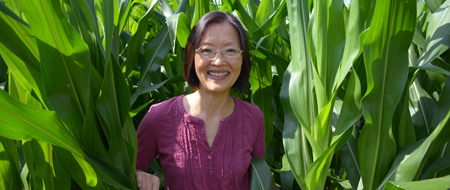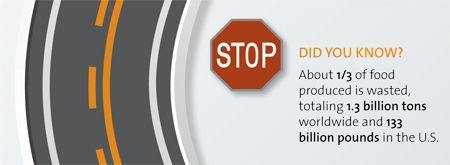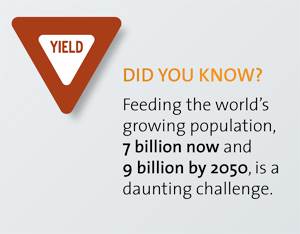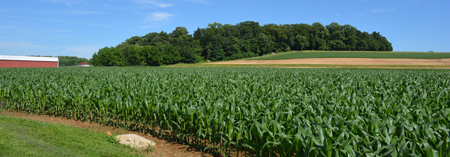The enormous amount of food waste generated from field to table to landfill in America is staggering, even more so when the resources needed to produce the food are considered.
This waste is occurring at the same time that families are going hungry. In fact, millions of Americans live in “food insecure” households, meaning that at times they do not have access or funds to purchase sufficient, safe, and nutritious food to meet their dietary needs.
Understanding the scope of food loss and waste in America, possible solutions, and the impact on food insecurity will be the focus of a unique national conference hosted by Penn Vet on December 8 and 9 at the Philadelphia campus.
The conference—The Last Food Mile: Food Loss and Food Waste in the U.S. Food Supply Chain—is funded by a $49,000 grant recently awarded to Penn Vet by the United States Department of Agriculture (USDA) through its Agriculture and Food Research Initiative.
“This is the first conference of its kind in the country,” said Dr. Zhengxia Dou, Professor of Agriculture Systems at Penn Vet’s New Bolton Center, who is chairing the conference organizing committee, along with Penn Vet’s Drs. Alan Kelly, David Galligan, and James Ferguson.

“Food loss and waste occurs in the field at harvest, and post-harvest during processing, marketing, distribution, and consumption,” Dou continued. “However, there are few comprehensive studies examining the extent, breadth, and depth of food loss and waste.”
Why would a veterinary school play a leading role in contributing to America’s food security and sustainability?
As Penn Vet Dean Joan Hendricks explained, “Veterinarians ensure that animals produce plentiful, safe, and affordable food, improving their productivity while addressing environmental and animal welfare concerns. Penn Vet is perfectly positioned to tackle the challenge of helping to reduce food waste in America, with an eye to reducing hunger as well.”
The topic of food waste and loss is one of critical importance in America, the USDA National Institute of Food and Agriculture wrote in its letter awarding the grant to Penn Vet. “The effort to address food loss and food waste throughout the value chain is also a strength of this conference,” the USDA noted. “Given the growing interest in this area, now is a great time for a research conference.”
More than two dozen experts from around the world will participate in panel discussions highlighting four food sectors: industry, consumer, recovery, and behavior change. Conference attendees will represent a broad spectrum of professional backgrounds and expertise, including industry executives, academics, authors, researchers, psychologists, lawyers, and Penn students. An estimated 200 people are expected to attend.
“We want to raise the awareness and spread the word,” said Dou. “We want people to share their experiences to discover what works best. We want to build a community through networking to help find solutions.”
Food Waste and Hunger
According to a 2010 USDA study, more than one-third of the food produced for human consumption in the United States is wasted each year—equaling 133 billion pounds of food, worth $161 billion.
“It’s astonishing,” Dou said. “It’s an economic issue. It’s a moral issue. It’s a health issue. It’s a sustainability issue. We are wasting so much food, when so many children are hungry and don’t have enough nutritious food to develop and lead healthy lives.”

Health and Productivity (CAHP), and she is perhaps the only soil scientist on the faculty of a veterinary school. After earning a master’s degree in China, Dou came to the United States to get her PhD in soil chemistry from Penn State University. She joined the Penn Vet faculty in 1997.
In addition to global food security, Dou’s research focuses on increasing efficiency in animal production systems and “agroecosystems,” the transformation and transport of nutrients, and the environmental impact of animal waste.
“At CAHP we emphasize productivity, such as how many pounds of milk a cow can produce, as well as profitability for the farmers and environmental sustainability,” she said. “These are all part of the picture of food security.”
Born and raised in China on a cooperative farm in an era of stagnation plagued with drought and famine, Dou has dedicated her life and work to food production and its environmental impact. “For at least the first 15 years of my life I was in chronic hunger,” Dou said. “So food is very, very important to me.”
What is Food Security?
“Food security” means that people have reliable access to a sufficient quantity of affordable, nutritious food. Most people would think everyone in the United States would be food secure. Not so. In fact, 49 million Americans live in “food insecure” households, including 16 million children.
Of the 7 billion people in the world today, 843 million are food insecure. In the developing world, one out of three children is undernourished. Looking into the future, it is estimated that by 2050 the world will have two billion more people.
 According to Dou, cutting down on food waste is critical to the sustainability of our planet—especially as the world population continues to grow. “How are we going to feed two billion more people when we now have more than 800 million people without enough to eat?” she asked.
According to Dou, cutting down on food waste is critical to the sustainability of our planet—especially as the world population continues to grow. “How are we going to feed two billion more people when we now have more than 800 million people without enough to eat?” she asked.
“There are hungry people everywhere,” Dou added, noting that the majority live in developing countries. “Most Americans don’t have an understanding of hunger and undernourishment.”
But in some poor areas of the U.S. there are “food deserts” lacking a steady supply of high-quality, fresh food. Convenience stores, maybe—but those often feature processed foods that are not nutritious.
The Impact of Food Waste
Food production uses valuable resources: land, water, energy, nutrients. And it has negative environmental consequences: erosion, water pollution, greenhouse gas emissions. Food production and provision leaves a huge environmental footprint.
“There are a lot of efforts worldwide to push for greater food production output, but there is very little attention on how to maximize the use of the food we already produce,” Dou said.
Food waste has come into focus in recent years. In 2011, the United Nations Food and Agriculture Organization reported that one-third of food produced worldwide for human consumption, or 1.3 billion tons of food, is wasted each year.
In addition, the 2010 USDA study estimates that 31 percent of edible food is lost at the end of the food supply chain in the United States, including retail grocery chains, restaurants, food service outlets, large food companies, and households.
As concern about food waste gains traction in the United States, some waste reduction and recycling efforts are afoot. These include bakeries and restaurants that donate their products, food pantries that distribute goods, and even people who glean food by going to fields to collect what is not harvested by farmers.
But there is no concerted national effort for food waste reduction. Explained Dou, “We need concerted efforts to examine the issues in a systematic way: where and how much food wastage occurs along the food supply chain, where is the critical control point, what interventions are most effective, and how to move forward collectively as a society.”

Penn Vet: Leading the Way
Penn Vet is committed to the One Health Initiative, a movement to forge collaborations among physicians, veterinarians, nurses, and other disciplines related to science and the environment. The Last Food Mile conference furthers the One Health mission by bringing together experts across many food-related fields for the benefit of improving animal health, human health, and the environment.
“The One Health concept has an inherently embedded component: the health of the environment,” Dou added. “The health of humans and animals is ultimately affected by the health of the environment: the water we drink, the air we breathe, the soil we rely on for growing food.”
Penn students are getting involved in the food waste and recovery issue. As part of an undergraduate course called The Politics of Food and Agriculture, offered in Penn’s School of Arts and Sciences, Dou is helping design a student research project on quantification and characterization of food waste streams in a Penn dining facility. About 30 students are enrolled in the fall semester class, taught by professors Mary Summers and Jane Kauer.
“If you are going to change the behavior, it is better to start with young people,” Dou said. “They are the consumers of the new generation.”
After spearheading the conference, Dou and her team plan to organize a group of papers to be published in a scientific journal, Global Food Security, to share their findings.
“I know first-hand that access to adequate amounts of food is important,” Dou said. “It’s not hard for me to imagine how it feels to be hungry. That's at the root of my interest in food and the reason food production and its environmental aspects have been my career.”